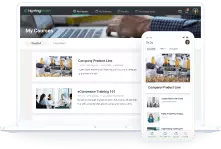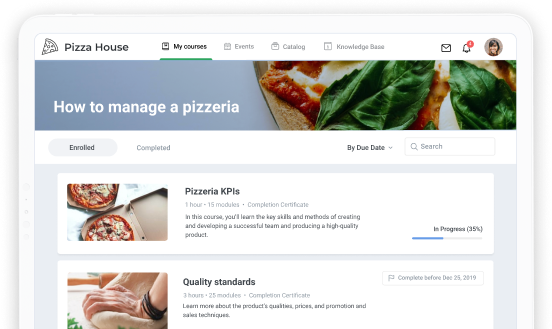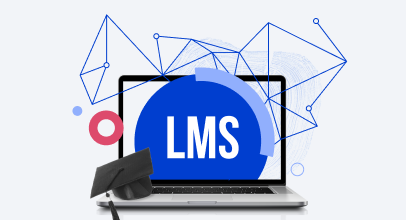eLearning Content Curation: A Strategy to Deliver Learning at the Speed of Need

Do you invest too much time and money in eLearning content development and are looking for ways to get the best “bang” for your training buck? It’s likely high time to rethink how you manage your training dollars. A strategy known as content curation allows you to make a wide array of training resources available to your learners at virtually no cost.
In this article, we will look at what content curation is and explore how organizations can use this strategy to nurture a culture of continuous learning to support on-the-job performance.
What is Content Curation?
Training Industry magazine defines it as follows:
“Content curation is the process of sorting through vast amounts of web-based and enterprise-based content and presenting it in an organized and meaningful format.”
An effective program of content curation includes a thorough search for information, a process to review content for accuracy and relevance, and a way to share the content with learners.

Creating vs. Curating Content
Let’s explore the difference between creating content and curating content in order to understand the benefits of each.
Content creation is the process of creating and distributing your own learning materials to your in-house audience of learners. Organizations own the content they create, so they can use and update this material however they wish.
Content curation involves searching online resources and databases, then gathering and sharing learning content that has high value to your learning audience. You do not own curated content, so you cannot alter it. If you find that your curated content has become outdated, you can remove it from your system and replace it with a resource that is more accurate and updated.
However, not all the content you find on the web can be curated. Here’s how to avoid the potential for intellectual property theft:
Obtain permission from the content owner before you share or reuse any content you find online. If this is a website, copyright status is usually noted at the bottom of a webpage using the copyright symbol (the letter C) and year, such as © 2020. Best practices for respecting copyrights include:
- Content created or shared through a government agency is generally considered to be in the public domain. Public domain content is freely available for reuse or sharing.
- Content found on sites like Wikipedia carries a creative commons (CC) license, and can generally be reused or shared, as long as proper credit is given to the original creator.
- When viewing websites owned by corporations, individuals, educational institutions, or non-profit agencies, search the FAQs or Policy notes for an established sharing policy. Follow the stated policy to safely share or link.
If no policy is given and you have questions about the reusability of any eLearning you find online, email the site owner to ask about copyright status and request permission to share, reuse, or link back to the content.
Content Curation Benefits and Disadvantages
Content curation can help you build a more robust training experience for your learners by adding a variety of content types to your curriculum. Other benefits of this strategy include:
- Reduces curriculum development time. Not every piece of eLearning needs to be created from scratch. There is a great amount of basic eLearning materials online, some of which can legally be shared or reused.
- Enhances the value of your overall curriculum. Well-curated online content can provide additional support resource for your existing learning materials.
- Offers just-in-time learning remediation. Curated content can be downloaded and accessed any time a learner needs a quick reminder on a particular topic.
- Creates a more interesting and engaging learning atmosphere. Not everyone one-and-done enjoys “traditional” learning methods. Why not use content curation to shake things up a bit? Videos, podcasts, blog posts, eBooks, and slide shares, can be made available to anyone with just a few mouse clicks.
- Supports a culture of learning. The days of training being a one-shot activity are long gone. Curating content allows learners to find, filter and access learning materials on a variety of topics they care about. They can also share links of interest with co-workers, which helps to increase learning engagement on a larger scale.
However, despite all these benefits, content curation is somehow problematic because it’s not entirely under your control.
- Misleading information. When you create the eLearning content on your own, you either have expertise in a subject or you work together with an SME, so you can be sure that the knowledge you want to transfer to your learners is reliable. In contrast, not all curated content is evidence based. When surfing the net, there is a big chance that you’ll run into biased and even false information.
- No one-size-fits-all content. Not all the eLearning materials you manage to curate will be a suitable fit for your learners. You’ll often need to customize the content, and this will require expertise on your part.
Content Curation Models
Content curation is a deliberate, focused series of activities to locate, access, and select information that benefits your organization’s learning needs. Marketing expert Rohit Bhargava’s five models of content curation offer a roadmap of best practices that can guide your training content curation:
- Aggregation. This is the act of searching for and identifying relevant online content and then saving links to that content in a single location. Aggregation gives your learning audience access to a great amount of information with a single click. However, learners will have to spend a significant amount of time to find really useful information among tons of resources.
- Distillation. This model involves filtering and sorting through an amount of stored information so that only the most important or relevant content is shared. Learners who access a distilled database will find fewer resources than in an aggregated database. However, since the act of distilling filters out links to unnecessary content, the result is a higher quality, more focused set of resources.
- Elevation. This is the process of analyzing trends across both social media and websites, and identifying a larger trend or insight from smaller daily musings posted online. Elevation is considered to be the most complex content curation approach because it requires more analytical expertise than other methods.
- Mashup. Also known as merging, this model involves combining content from two or more existing sources to create a new perspective or theme. Mashups in learning and development often occur on discussion boards or wikis, as multiple participants offer their input into a single document.
- Chronology. This is a curation strategy that organizes information based on a timeline. Many blogs are set up to display postings by date, from most recent to oldest. Curating by chronology is fairly easy to do and can provide an interesting way to see how ideas and information evolves over time.
How to Curate Content for Learning
It’s important to decide on a content curation process prior to collecting resources and links. A process provides you with a framework that can be used by everyone involved in collecting and sharing information. Your process should focus on finding and delivering high-value content to your learners. Here are some suggestions to get you started:
Step 1: Define content goals
Look at the job roles within your company and consider what you want to achieve at each level. For example, executives may need to stay up to date on industry trends, while people leaders could master their coaching and motivation skills.
Step 2: Identify learning needs and constraints
It’s important that you provide the right kind of learning content to each audience of learners. For instance, newly promoted managers may have a great need to learn but little time for training. In this case, a series of targeted microlearnings, short podcasts, and blog posts would provide ideal learning support for new leaders.
Step 3: Find resources
The internet connects us with a world of learning resources, so don’t limit yourself to searching for content with just a few keywords. Go on a webquest and search for content ideas in:
- Your organization’s internal databases. Your company website, intranet, message boards, wikis, and internal social media applications are a treasure trove of content that is already customized to your learners’ needs.
- Educational websites. Some top-tier universities make their course outlines and materials publicly available on their websites. Educational organizations, colleges, and technical schools may also offer links to learning content and virtual learning events.
- Trade associations. They often post newsletters, articles, and details about best practices for various jobs within various industries on their websites.
- Video tutorials. Sites such as YouTube, Howcast, and CosmoLearning offer tons of high-quality video tutorials on just about any topic you can think of. Sites such as Lynda.com, Coursera, EdX, and Udemy provide access to excellent business and technical training programs for a small fee.
- Follow the (thought) leaders. BigThink and TED offer video lectures and interviews from world-renowned thought leaders in a range of fields.
- Online media sites. Local, national, and international publications and media outlets all have a strong digital presence. You can subscribe to a news feed and receive content on a daily or weekly basis from just about any global news provider.
- Local resources, such as your city, county, and state government can also be a great source of community news and information.
- Bloggers and podcasters. Find the most credible bloggers and podcasters in your industry and subscribe to their feeds.
- Social media. If you can access social media sites from behind your corporate firewall, set up user accounts on Twitter, Instagram, Facebook, and LinkedIn. Select topics of interest from their news feeds and you’ll receive updates and links to content aligned with your needs.
Step 4: Share content
You can share content by emailing your audience or posting an update to an internal social network. You can also provide access via your intranet or SharePoint portal and integrate the links within other internal systems and platforms. But these methods don’t offer any insight about how your content was viewed or its level of relevance to your audience. That is why, in many companies, the learning management system (LMS) has become the default method for sharing curated learning content.
An LMS is a software application that administers, deploys, tracks, and reports on all training activities for an organization. It serves as a single repository for all content and allows you to track learning access, activity, and completion over time.
You can use an LMS to deploy all types of learning materials, including presentations, documents, videos, podcasts, and SCORM courses. It enables you to organize and sequence your content for delivery in logical ways. For example, you can group the content by type and deliver video content on its own “channel” or set up a virtual document library that stores content by topic.
You can also deliver your curated content through a series of learning tracks. Learning tracks create a linear flow that guides users through a variety of curated content over time.
If your organization does not yet have an LMS, try iSpring Learn LMS.
Step 5: Analyze results
To assess the relevance and impact of your resources, it’s important to gather feedback from your learners on the curated content they consume. You can use this information to understand how well your content supports your overall learning and development efforts.
If you use an LMS, you should also pull reports on user data for all content accessed. iSpring Learn LMS offers detailed reporting on both content and users. This functionality allows you to track learning activities on a wider level to see which kinds of content are most helpful for your team members, and which should be updated, improved, or replaced.
Best Content Curation Strategies for eLearning
Content curation should not be a stand-alone effort. Here are a few ideas on how to use content curation to support your existing learning strategies.
Blended learning
Extend the sense of engagement and interest that learners feel during a blended learning experience by offering follow-up tips and information via email or newsletter. Providing regular updates reinforces the skills your learners gained from the course and decreases the likelihood that knowledge will be lost.
Social learning
Many organizations struggle to create and sustain social learning, mostly because of the sheer volume of content available on social media sites. Knowing how to find, filter, and automate the right types of content can make an enormous difference.
Start by finding a few credible, high-quality sources of social learning content. Look for podcasts or blogs created by industry leaders and then subscribe to their feed. Set up a Google news search for stories that meet specific criteria related to your organizational needs. Follow your industry’s thought leaders on platforms like LinkedIn or Twitter.
Setting specific parameters is key for curating social learning content. Your goal should be to collect the best information on a few specific topics from the people and organizations that are the most credible in their fields.
Motivation
Motivating your experienced employees to stay on top of emerging knowledge and trends can be a challenge. Employers who seek to foster loyalty and encourage employee retention know that providing access to a variety of high-quality training experiences is a win-win proposition.
For example, you can ask your learners to compare and contrast how your current processes compare with those that others in your job area or industry are using. Encourage your team members to come up with ways to improve processes and share knowledge on a wider level.
Collaboration
An organization’s collective intelligence is one of its greatest business assets. You can use a content curation process to create a culture of knowledge sharing among your employees.
You can tie your knowledge collaboration program to a social learning initiative as a way to encourage frequent participation. Set rules for engagement and standards for sharing social learning. In the early stages of this initiative, you may want to use an aggregation model to curate content. As your volume of shared knowledge links grows, you can move to a distilled model to organize content by topic or job skill.
Conclusion
Content curation is a cost-effective way to add a variety of types of content to your learning curriculum. Don’t attempt to capture every piece of content available; instead, focus your efforts on finding and sharing the content types your learners prefer from the most credible resources you can find.









